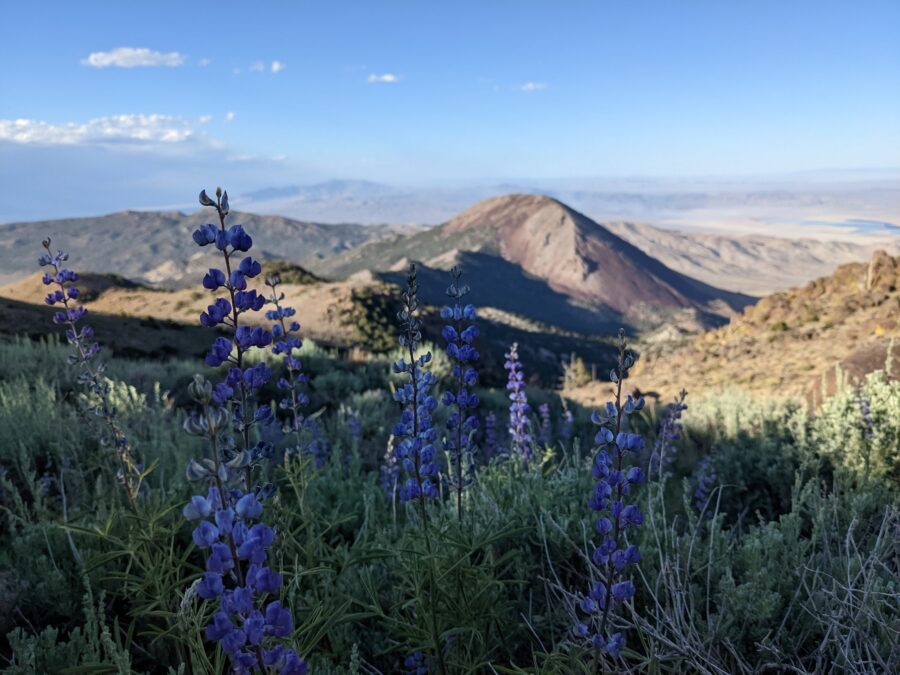
Black Holes, White Gold: A Floristic Inventory of the Silver Peak Range, Esmeralda County, NV.
Master’s student Peri Lee Pipkin, studying botany at the California Botanic Garden, has been working on compiling an inventory of all known plants in the Silver Peak mountain range of Esmeralda County, NV. Located about an hour from Bishop, CA, the area is high in biodiversity and is home to multiple rare plants and animals. These beautiful mountains are home to Bristlecone pines (Pinus longaeva), mountain-top vernal pools, pinyon juniper forests, sagebrush steppes, creeks and mossy canyons, and alkali wetlands and hot springs. It’s also rich in human history, with many arrowheads and ruins to be seen. So far, close to 1800 collections have been made representing a little over 400 plant taxa! Nevada’s botanical diversity is largely under-documented, and the Silver Peak Range is what’s known as a “botanical black hole”, so next season may bring some new and interesting finds as well.
Despite the lack of botanical documentation, we know that the Silver Peak Range is home to rare and endangered species such as Tiehm’s buckwheat (Eriogonum tiehmii) and Tecopa bird’s beak (Chloropyron tecopenseis). Its proximity to other specialized habitats, such as those located in the White Mountains and Death Valley National Park in California, as well as the presence of unique ecosystems such as alkali wetlands lends potential for this area to host high levels of species richness and endemism. It also straddles the transition zone between the Great Basin and Mojave deserts, and includes the northernmost extent of the western Joshua trees (Yucca brevifolia), a species predicted to undergo widespread extirpation in the southernmost region of their range. In addition to this, a rare wildflower, Chloropyron tecopense (Tecopa Bird’s Beak), grows in the area wetlands and depends on groundwater for survival. In its narrow habitat range, groundwater extraction for agriculture and geothermal energy threaten the Tecopa Bird’s Beak and many other rare plants and animals found in this unique desert wetland. The subalpine peaks of the range descend into unusual geology that bears both diverse plant communities and mineral rich soil, some of which are notably high in lithium. Because of this, the region is a hot-spot for proposed lithium extraction, a critical mineral in our transition to renewable energy sources. This leaves the area immediately vulnerable to the destructive practices of resource extraction. As an increasing demand for minerals grows and new projects are being proposed on public lands, baseline biological data is needed to inform management decisions that can maximize protection of biodiversity.



Collecting herbarium specimen data and understanding geographic patterns of plant diversity can inform appropriate siting of mineral extraction and energy development in order to reduce conflicts with sensitive resources such as rare plants and ecological communities. This project will provide much needed data for an understudied and rare plant species facing existential conservation threats. These factors also underscore the urgency and importance of a floristic inventory in this region. The White Mountain Research Station provided a very lovely and supportive basecamp for this research project this summer! If you’d like to volunteer to help with collecting efforts this summer, please get in touch with Peri Lee! (ppipkin@calbg.org) The season starts around May and goes through mid July and offers a chance to see spring wildflower blooms, subalpine trails with views of the Sierras, Whites, and Death Valley, and beautiful desert scenery.
Peri Lee Pipkin was a 2022 WMRC Mini Grant Recipient.